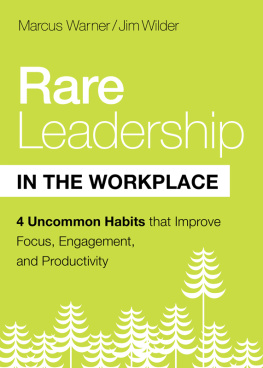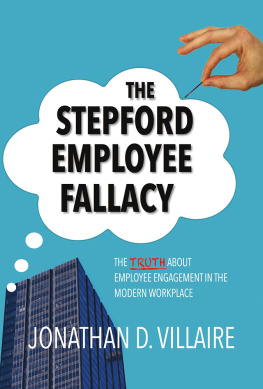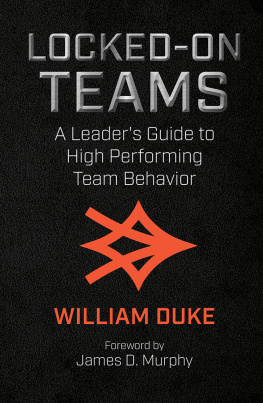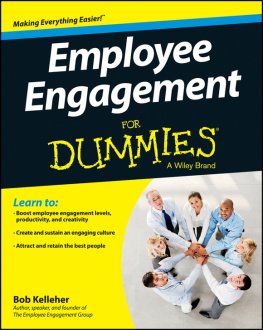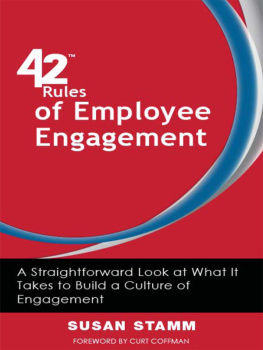Thank you for downloading this Simon & Schuster ebook.
Get a FREE ebook when you join our mailing list. Plus, get updates on new releases, deals, recommended reads, and more from Simon & Schuster. Click below to sign up and see terms and conditions.
CLICK HERE TO SIGN UP
Already a subscriber? Provide your email again so we can register this ebook and send you more of what you like to read. You will continue to receive exclusive offers in your inbox.
CONTENTS
What Todays Best Managers Are Doing Differently
How to Engage Millennials, Gen Xers, and Boomers
Give the Man His Guitar
Help New People and Teams Work Faster and Smarter
Inspire Innovation Through Healthy Discord
Create Alignment Around Serving Them
What We Can Learn from the Fall of Constantinople
Small Ideas That Drive Big Results
INTRODUCTION
SOLVING THE MODERN PROBLEMS OF TEAMWORK
What Todays Best Managers Are Doing Differently
C hris Hadfield looks like a fireman, or maybe a high-school biology teacher. Hes neither. The trim, mustachioed Canadian is an astronaut and a member of a select group of only two hundred people who have walked in space. Forbes has called him the most famous astronaut since Neil Armstrong. During his five-month stint as commander on the International Space Station, he was certainly the most social-media savvy. Hadfield gave up the first few hours of shut-eye each night so he could float around sending messages via Facebook and Twitter about stuff that most astronauts take for granted but the rest of us find fascinating, like how to make a sandwich in microgravity, how to get your hair cut, or how to wring out a washcloth.
Millions watched Hadfields messages, and he did more to generate public interest in space travel than anyone for decades. But his greatest contribution may not be in his tweets and posts, but in the way he led his diverse team. He told us that before he assumed his role as commander, he knew the mission would be a management challenge. His team was comprised of smart, driven Americans and Russiansthe oldest and youngest two and a half decades apart in age. Not only might generational divides develop, but language barriers and cultural misunderstandings could create issues. And here was a young man from Sarnia, Ontariowho looks a lot like an after-school driving instructorand he was about to tell them what to do twenty-four hours a day.
So, before they even thought about strapping themselves into their rocket, Hadfield got to know his people. He taught himself Russian. He moved to the United States for a time, and then to Russia, where he didnt live in a hotel but in state housing. Then, he brought his team together to learn how they could respect each other and work best together. The six met each others families, heard everyones back stories, ate Big Macs, and downed a little vodka. Hadfield even had them role play how they would support each other if one of them lost a loved one while in space, which, remarkably, did happen to one of the astronauts during their mission. Hadfields goal: By the time they rocketed out of orbit, he wanted them to not just be coworkers but a codified, unified team.
Their mission was wildly successful from a scientific and public relations perspective; but more remarkably, during their five months in space, Hadfield told us his team members never had a single heated argument. Not one. They worked together beautifully.
We all know how hard it can be to get our stressed out, spread thin modern teams to work together when they can go home after eight or nine hours, let alone when theyre [S]itting in a tin can far above the world. The new kid isnt pulling his weight. Ruth isnt responding to my texts. Does Sarah have to send an email about everything? Steve is focused on the wrong stuff! What team leader isnt hearing such gripes, or others? Hadfields multigenerational, global team eschewed such bickering and operated in harmony because he understood how certain soft skills can help build todays best teams. By using his considerable leadership talents, he came up with resourceful ways of creating bonds of understanding among his team members that went well beyond the standard rule book for running the station.
In space, he explained to us, there are lots of written rules: There are books full of them. They are important because when you dont follow procedures, things can go wrong and everyone could, well, die. Usually the margin of error is a few seconds. In the opening scene of the movie Gravity , an astronaut, played by actress Sandra Bullock, disobeys mission control and her leader (actor George Clooney) for just a moment. Hadfield told us that would never happen in real life. Astronauts always follow the rules. They are sacrosanct. Yet Hadfields team was equally committed to one unwritten rule, which they collectively came up with, that became just as important as the formal ones: Each member of the crew had to do one unsolicited kind thing for every other member of the crew every single dayfor five months.
Hadfield said these random acts of kindness were often anonymous. One astronaut might help cook a meal when it wasnt his turn, another might tidy up a sleeping area for a crewmate who had to rush to duty, another might check a piece of support equipment or clean a filter for a team member who needed to get some rest. These actions focused each person on serving others, versus themselves, and kept tempers in check and egos in the right place. This one simple practice had a profound effect; Hadfield, in fact, credits it as being the most impactful in bringing his team together.
EVIDENCE OF PAYOFFS
Now, more than ever, businesses need great team leaders like Chris Hadfield, those with strong team leadership skills. The current era of unprecedented change in business has been described with another acronym to add to our lexicon: VUCA (pronounced voo-ka ), which stands for volatility, uncertainty, complexity, and ambiguity. And one of the ways in which organizations are seeking to meet the challenges of a VUCA world is by making more work team-based. In fact, if you havent noticed, we are smack-dab amid a massive shift toward more collaboration. Already, in the average company, up to 80 percent of employees days are spent working in teams and, in a Deloitte survey of 7,000 senior executives in 130 countries, almost half said their companies were either in the middle of restructuring, or about to embark on it, to put more emphasis on teamwork.
The vogue for teams is driven by evidence for potential payoffs in higher-quality and faster problem-solving, which includes a fascinating study from professors at the University of Central Florida and a research psychologist with the U.S. Army that found the most effective teams have a collective intelligence that allows them to get more work done and spot problems quicker. Weve also found that when people feel they are part of a collaborative, communicating work group they are overall happier on the job, which tends to make people more productive and efficient. All good stuff. Stanford and University of Michigan professors also have shown those in positive team environments have fewer accidents and health care costs 50 percent lower than those of their peers who are not in great teams.
Another payoff: The diversity of knowledge and experience that good teams bring to assignments allows them to be more responsive to customersespecially those of different ages and cultures for instance. And its well documented that team collaboration spurs greater creativity and therefore more rapid innovation for customers, which is vital in todays ultra-competitive and rapidly evolving business environment. The need to develop more smart products, for example, which capitalize on the potential of new technologies, is requiring increased collaboration across departmentswork that is best achieved by cross-functional teams.
Next page


